Abstract
OBJECTIVE: To validate the safety of gadolinium-diethylenetriamine pentaacetic acid (GD-DTPA) by measuring its effect on pancreatic capillary perfusion and acinar injury in acute pancreatitis. BACKGROUND: Contrast-enhanced computed tomography (CECT) is proposed as a gold standard for early evaluation of acute necrotizing pancreatitis. However, iodinated contrast media used for CECT have been shown in these circumstances to reduce pancreatic capillary flow and increase necrosis and mortality. Recent reports suggest that post-GD MRI provides images comparable to CECT in the assessment of severe acute pancreatitis. METHODS: Necrotizing pancreatitis was induced in 14 Wistar rats by intraductal glycodeoxycholic acid (10 mM/L) and intravenous caerulein (5 microg/kg/h) over 6 hours. Intravital microscopic quantitation of pancreatic capillary blood flow was performed using fluorescein isothiocyanate-labeled erythrocytes after induction of pancreatitis and 30 and 60 minutes after an intravenous bolus of either Ringer's solution or GD-DTPA (0.2 mL/kg). RESULTS: The two study groups were comparable with regard to mean arterial pressure, heart rate, arterial blood gases, hematocrit, amylase, lipase, and trypsinogen activation peptide production throughout the experiment. GD-DTPA did not reduce capillary flow (1.93 +/- 0.05 nL/capillary/min) compared to animals infused with Ringer's solution (1.90 +/- 0.06 nL/capillary/min). CONCLUSIONS: Intravenous injection of GD-DTPA does not further impair pancreatic microcirculation or increase acinar injury in acute necrotizing pancreatitis. Because of this advantage over CT contrast medium, further development of MRI as a staging tool in acute pancreatitis seems desirable.
Full text
PDF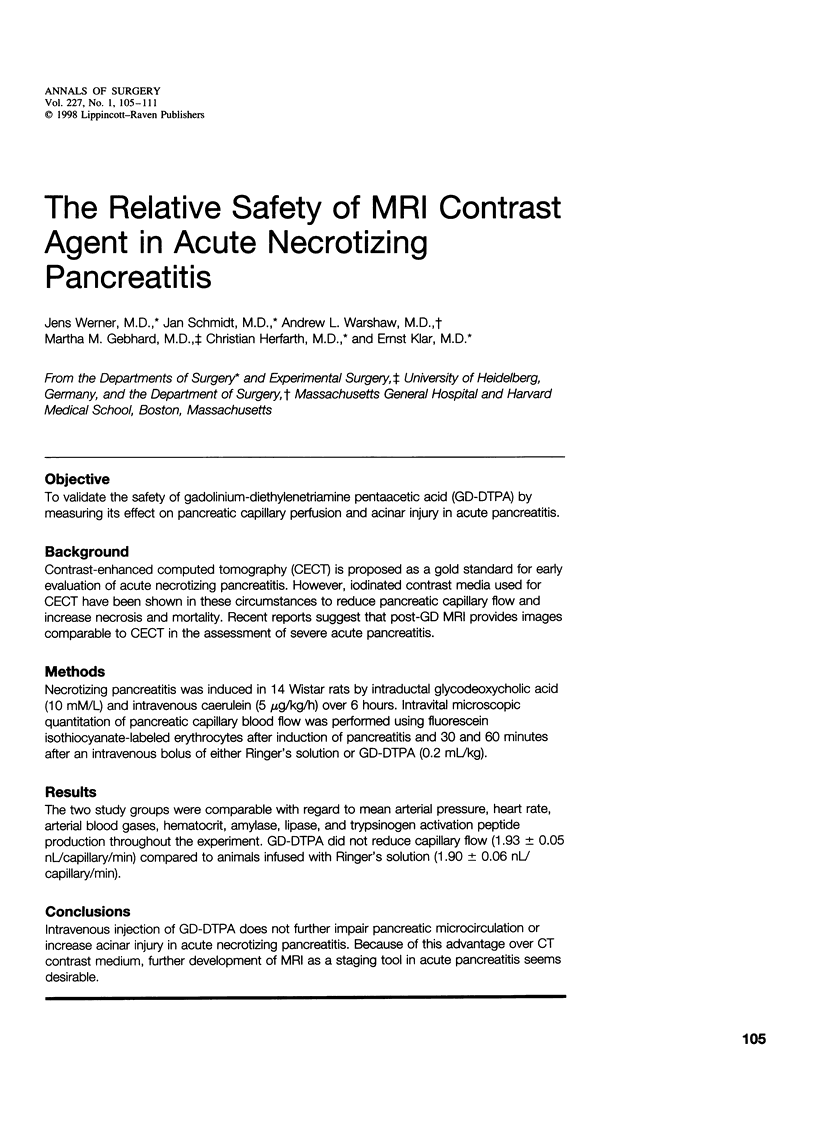
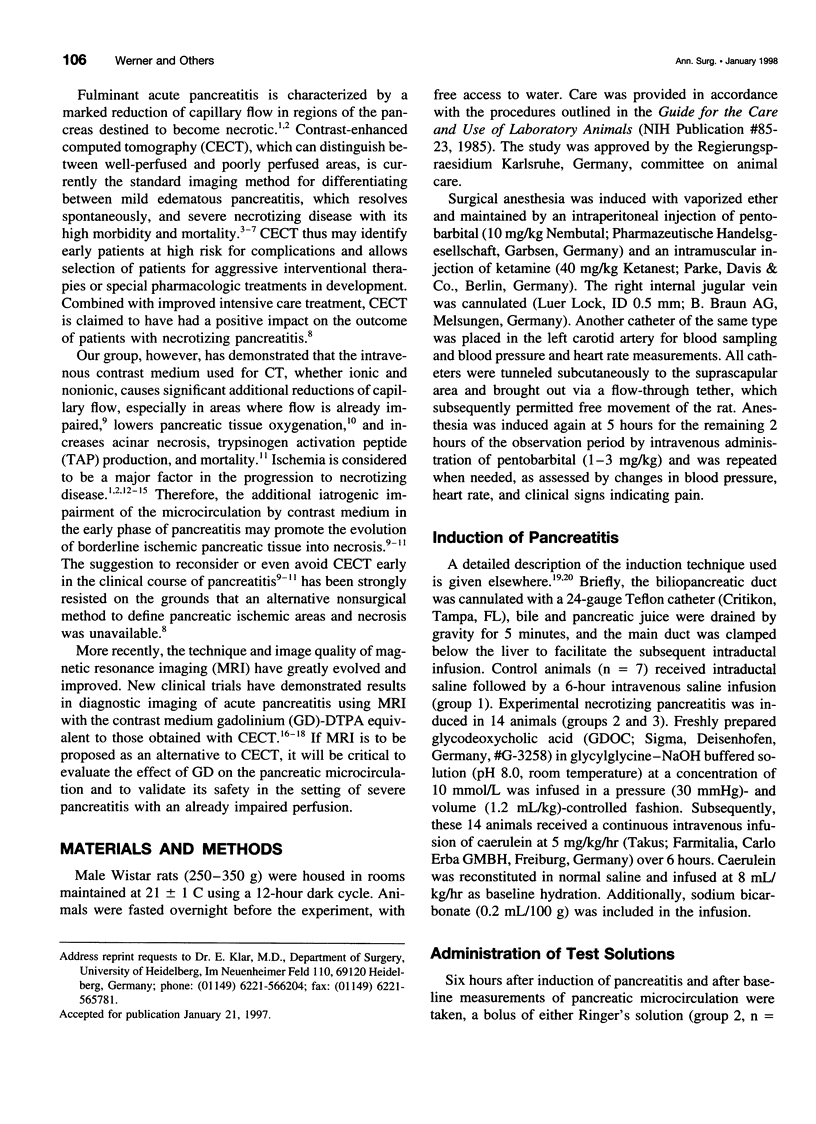
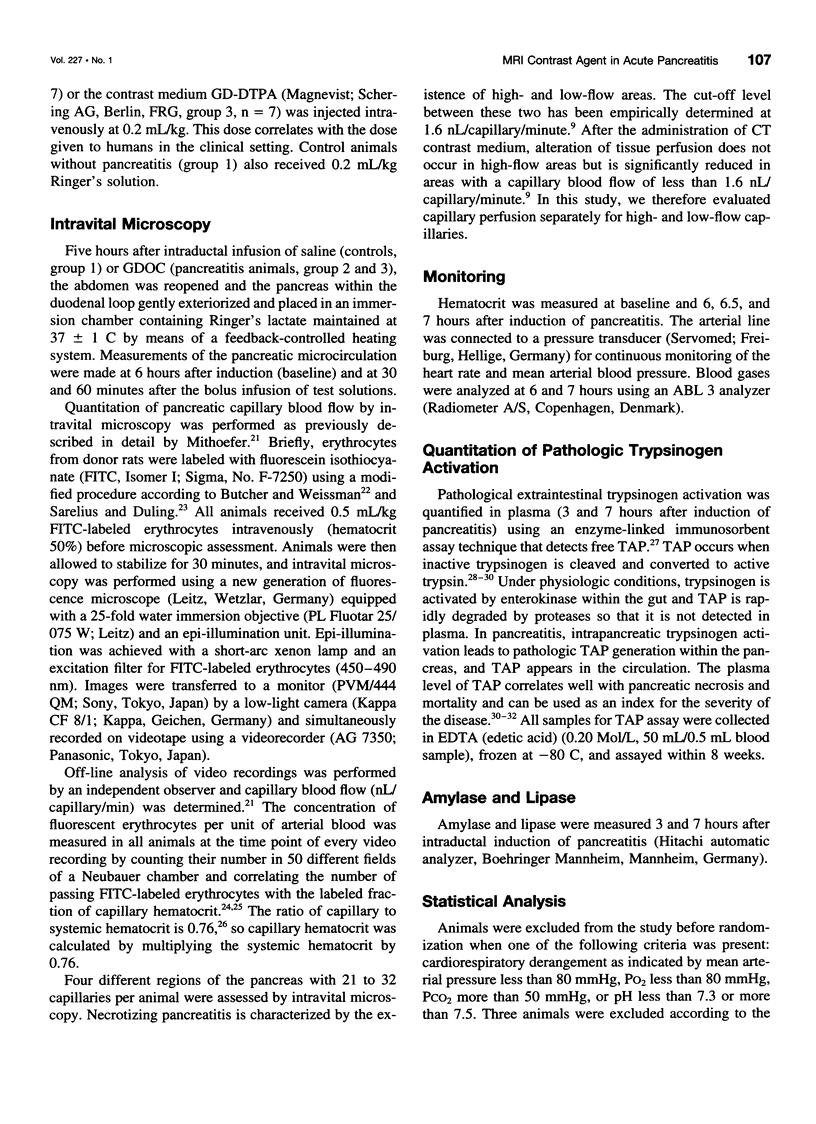
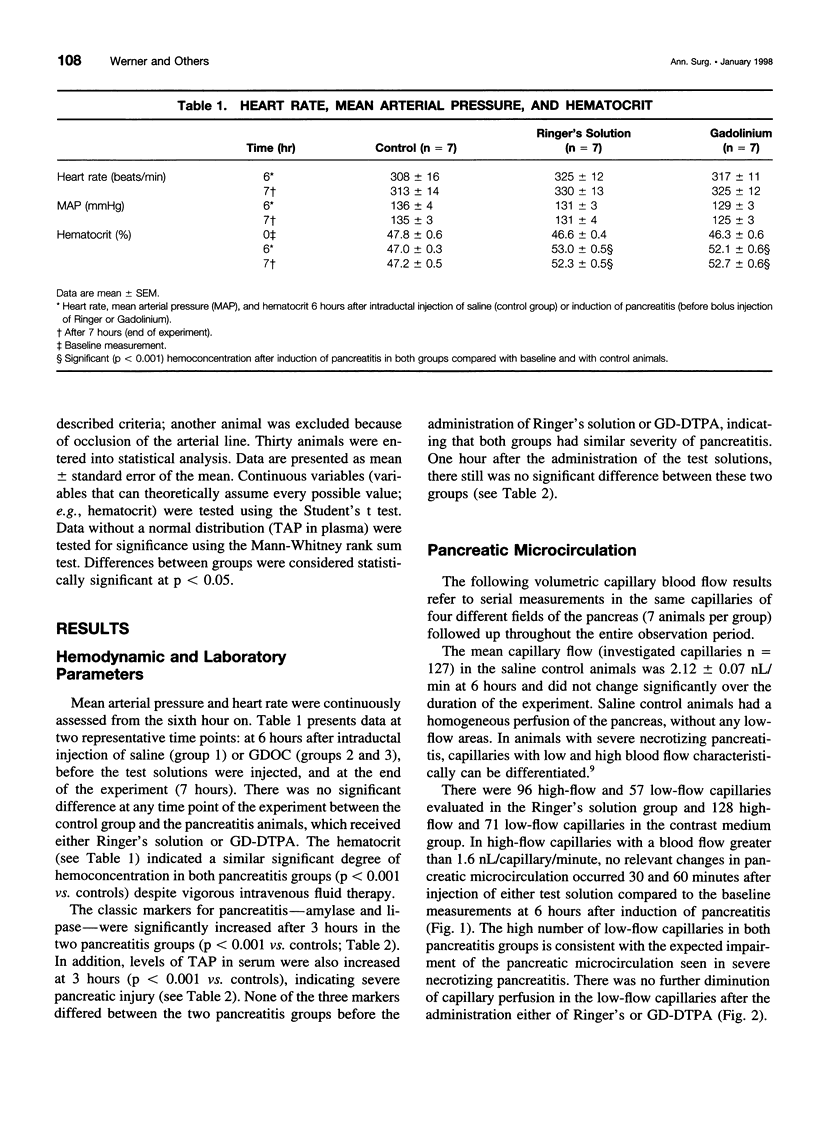

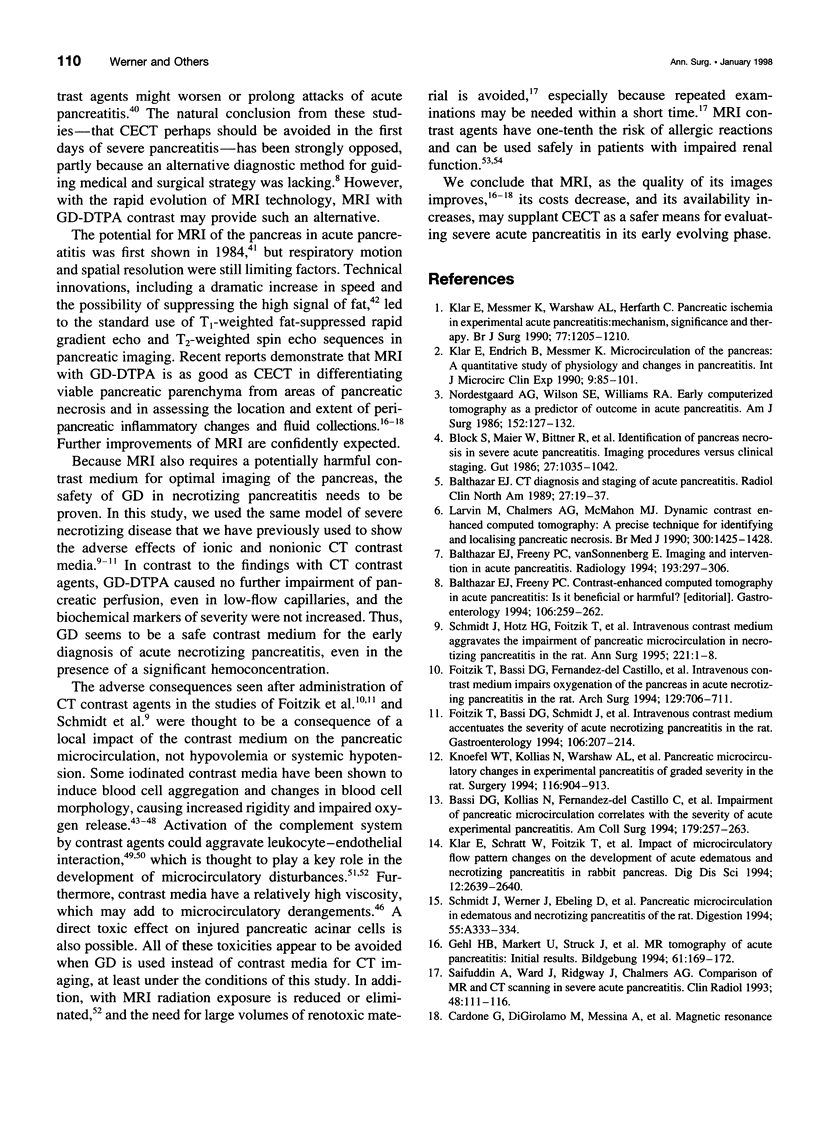
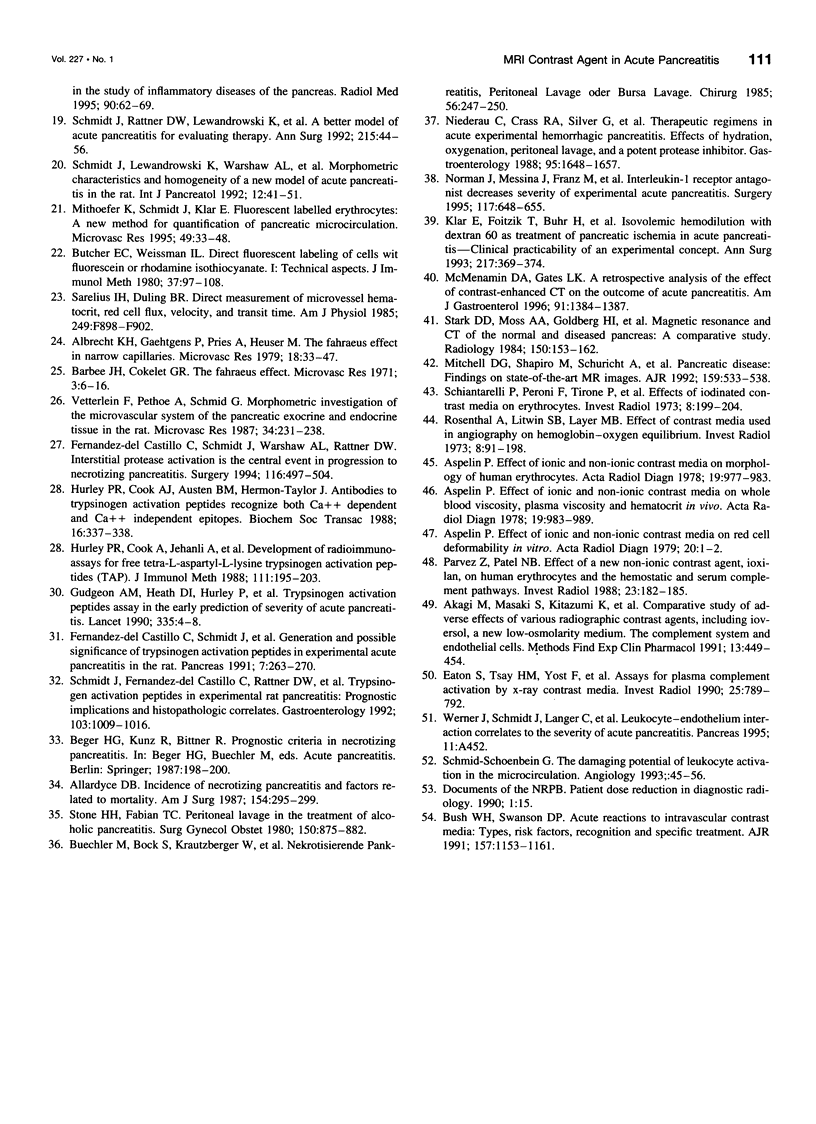
Selected References
These references are in PubMed. This may not be the complete list of references from this article.
- Akagi M., Masaki S., Kitazumi K., Mio M., Tasaka K. Comparative study of the adverse effects of various radiographic contrast media, including ioversol, a new low-osmolarity medium. II. The complement system and endothelial cells. Methods Find Exp Clin Pharmacol. 1991 Sep;13(7):449–454. [PubMed] [Google Scholar]
- Albrecht K. H., Gaehtgens P., Pries A., Heuser M. The Fahraeus effect in narrow capillaries (i.d. 3.3 to 11.0 micron). Microvasc Res. 1979 Jul;18(1):33–47. doi: 10.1016/0026-2862(79)90016-5. [DOI] [PubMed] [Google Scholar]
- Allardyce D. B. Incidence of necrotizing pancreatitis and factors related to mortality. Am J Surg. 1987 Sep;154(3):295–299. doi: 10.1016/0002-9610(89)90614-4. [DOI] [PubMed] [Google Scholar]
- Aspelin P. Effect of ionic and non-ionic contrast media on red cell deformability in vitro. Acta Radiol Diagn (Stockh) 1979;20(1):1–12. doi: 10.1177/028418517902001a01. [DOI] [PubMed] [Google Scholar]
- Aspelin P. Effect of ionic and non-ionic contrast media on whole blood viscosity, plasma viscosity and hematocrit in vitro. Acta Radiol Diagn (Stockh) 1978;19(6):977–989. doi: 10.1177/028418517801900613. [DOI] [PubMed] [Google Scholar]
- Balthazar E. J. CT diagnosis and staging of acute pancreatitis. Radiol Clin North Am. 1989 Jan;27(1):19–37. [PubMed] [Google Scholar]
- Balthazar E. J., Freeny P. C. Contrast-enhanced computed tomography in acute pancreatitis: is it beneficial or harmful? Gastroenterology. 1994 Jan;106(1):259–262. doi: 10.1016/s0016-5085(94)96077-1. [DOI] [PubMed] [Google Scholar]
- Balthazar E. J., Freeny P. C., vanSonnenberg E. Imaging and intervention in acute pancreatitis. Radiology. 1994 Nov;193(2):297–306. doi: 10.1148/radiology.193.2.7972730. [DOI] [PubMed] [Google Scholar]
- Barbee J. H., Cokelet G. R. The Fahraeus effect. Microvasc Res. 1971 Jan;3(1):6–16. doi: 10.1016/0026-2862(71)90002-1. [DOI] [PubMed] [Google Scholar]
- Bassi D., Kollias N., Fernandez-del Castillo C., Foitzik T., Warshaw A. L., Rattner D. W. Impairment of pancreatic microcirculation correlates with the severity of acute experimental pancreatitis. J Am Coll Surg. 1994 Sep;179(3):257–263. [PubMed] [Google Scholar]
- Block S., Maier W., Bittner R., Büchler M., Malfertheiner P., Beger H. G. Identification of pancreas necrosis in severe acute pancreatitis: imaging procedures versus clinical staging. Gut. 1986 Sep;27(9):1035–1042. doi: 10.1136/gut.27.9.1035. [DOI] [PMC free article] [PubMed] [Google Scholar]
- Bush W. H., Swanson D. P. Acute reactions to intravascular contrast media: types, risk factors, recognition, and specific treatment. AJR Am J Roentgenol. 1991 Dec;157(6):1153–1161. doi: 10.2214/ajr.157.6.1950858. [DOI] [PubMed] [Google Scholar]
- Butcher E. C., Weissman I. L. Direct fluorescent labeling of cells with fluorescein or rhodamine isothiocyanate. I. Technical aspects. J Immunol Methods. 1980;37(2):97–108. doi: 10.1016/0022-1759(80)90195-7. [DOI] [PubMed] [Google Scholar]
- Büchler M., Block S., Krautzberger W., Bittner R., Beger H. G. Nekrotisierende Pankreatitis: Peritoneal-Lavage oder Bursa-Lavage? Ergebnisse einer prospektiven konsekutiven kontrollierten Studie. Chirurg. 1985 Apr;56(4):247–250. [PubMed] [Google Scholar]
- Cardone G., Di Girolamo M., Messina A., Chichiarelli A., Innacoli M., Di Cesare E., Lupattelli L., Passariello R. La Risonanza Magnetica nello studio delle malattie infiammatorie del pancreas. Radiol Med. 1995 Jul-Aug;90(1-2):62–69. [PubMed] [Google Scholar]
- Eaton S., Tsay H. M., Yost F., Tweedle M. F. Assays for plasma complement activation by x-ray contrast media. Invest Radiol. 1990 Jul;25(7):789–792. doi: 10.1097/00004424-199007000-00007. [DOI] [PubMed] [Google Scholar]
- Fernández-del Castillo C., Schmidt J., Rattner D. W., Lewandrowski K., Compton C. C., Jehanli A., Patel G., Hermon-Taylor J., Warshaw A. L. Generation and possible significance of trypsinogen activation peptides in experimental acute pancreatitis in the rat. Pancreas. 1992;7(3):263–270. doi: 10.1097/00006676-199205000-00001. [DOI] [PubMed] [Google Scholar]
- Fernández-del Castillo C., Schmidt J., Warshaw A. L., Rattner D. W. Interstitial protease activation is the central event in progression to necrotizing pancreatitis. Surgery. 1994 Sep;116(3):497–504. [PubMed] [Google Scholar]
- Foitzik T., Bassi D. G., Fernández-del Castillo C., Warshaw A. L., Rattner D. W. Intravenous contrast medium impairs oxygenation of the pancreas in acute necrotizing pancreatitis in the rat. Arch Surg. 1994 Jul;129(7):706–711. doi: 10.1001/archsurg.1994.01420310038006. [DOI] [PubMed] [Google Scholar]
- Foitzik T., Bassi D. G., Schmidt J., Lewandrowski K. B., Fernandez-del Castillo C., Rattner D. W., Warshaw A. L. Intravenous contrast medium accentuates the severity of acute necrotizing pancreatitis in the rat. Gastroenterology. 1994 Jan;106(1):207–214. doi: 10.1016/s0016-5085(94)95457-7. [DOI] [PubMed] [Google Scholar]
- Gehl H. B., Markert U., Struck J., Bruch H. P., Weiss H. D. MR-Tomographie der akuten Pankreatitis: Erste Ergebnisse. Bildgebung. 1994 Sep;61(3):169–172. [PubMed] [Google Scholar]
- Gudgeon A. M., Heath D. I., Hurley P., Jehanli A., Patel G., Wilson C., Shenkin A., Austen B. M., Imrie C. W., Hermon-Taylor J. Trypsinogen activation peptides assay in the early prediction of severity of acute pancreatitis. Lancet. 1990 Jan 6;335(8680):4–8. doi: 10.1016/0140-6736(90)90135-r. [DOI] [PubMed] [Google Scholar]
- Hurley P. R., Cook A., Jehanli A., Austen B. M., Hermon-Taylor J. Development of radioimmunoassays for free tetra-L-aspartyl-L-lysine trypsinogen activation peptides (TAP). J Immunol Methods. 1988 Jul 22;111(2):195–203. doi: 10.1016/0022-1759(88)90127-5. [DOI] [PubMed] [Google Scholar]
- Klar E., Endrich B., Messmer K. Microcirculation of the pancreas. A quantitative study of physiology and changes in pancreatitis. Int J Microcirc Clin Exp. 1990 Feb;9(1):85–101. [PubMed] [Google Scholar]
- Klar E., Foitzik T., Buhr H., Messmer K., Herfarth C. Isovolemic hemodilution with dextran 60 as treatment of pancreatic ischemia in acute pancreatitis. Clinical practicability of an experimental concept. Ann Surg. 1993 Apr;217(4):369–374. doi: 10.1097/00000658-199304000-00008. [DOI] [PMC free article] [PubMed] [Google Scholar]
- Klar E., Messmer K., Warshaw A. L., Herfarth C. Pancreatic ischaemia in experimental acute pancreatitis: mechanism, significance and therapy. Br J Surg. 1990 Nov;77(11):1205–1210. doi: 10.1002/bjs.1800771104. [DOI] [PubMed] [Google Scholar]
- Klar E., Schratt W., Foitzik T., Buhr H., Herfarth C., Messmer K. Impact of microcirculatory flow pattern changes on the development of acute edematous and necrotizing pancreatitis in rabbit pancreas. Dig Dis Sci. 1994 Dec;39(12):2639–2644. doi: 10.1007/BF02087702. [DOI] [PubMed] [Google Scholar]
- Knoefel W. T., Kollias N., Warshaw A. L., Waldner H., Nishioka N. S., Rattner D. W. Pancreatic microcirculatory changes in experimental pancreatitis of graded severity in the rat. Surgery. 1994 Nov;116(5):904–913. [PubMed] [Google Scholar]
- Larvin M., Chalmers A. G., McMahon M. J. Dynamic contrast enhanced computed tomography: a precise technique for identifying and localising pancreatic necrosis. BMJ. 1990 Jun 2;300(6737):1425–1428. doi: 10.1136/bmj.300.6737.1425. [DOI] [PMC free article] [PubMed] [Google Scholar]
- MacLean L. D. The repair of inguinal hernias. Ann Surg. 1995 Jan;221(1):1–2. doi: 10.1097/00000658-199501000-00001. [DOI] [PMC free article] [PubMed] [Google Scholar]
- McMenamin D. A., Gates L. K., Jr A retrospective analysis of the effect of contrast-enhanced CT on the outcome of acute pancreatitis. Am J Gastroenterol. 1996 Jul;91(7):1384–1387. [PubMed] [Google Scholar]
- Mitchell D. G., Shapiro M., Schuricht A., Barbot D., Rosato F. Pancreatic disease: findings on state-of-the-art MR images. AJR Am J Roentgenol. 1992 Sep;159(3):533–538. doi: 10.2214/ajr.159.3.1503018. [DOI] [PubMed] [Google Scholar]
- Mithöfer K., Schmidt J., Gebhard M. M., Buhr H. J., Herfarth C., Klar E. Measurement of blood flow in pancreatic exchange capillaries with FITC-labeled erythrocytes. Microvasc Res. 1995 Jan;49(1):33–48. doi: 10.1006/mvre.1995.1004. [DOI] [PubMed] [Google Scholar]
- Niederau C., Crass R. A., Silver G., Ferrell L. D., Grendell J. H. Therapeutic regimens in acute experimental hemorrhagic pancreatitis. Effects of hydration, oxygenation, peritoneal lavage, and a potent protease inhibitor. Gastroenterology. 1988 Dec;95(6):1648–1657. doi: 10.1016/s0016-5085(88)80091-x. [DOI] [PubMed] [Google Scholar]
- Nordestgaard A. G., Wilson S. E., Williams R. A. Early computerized tomography as a predictor of outcome in acute pancreatitis. Am J Surg. 1986 Jul;152(1):127–132. doi: 10.1016/0002-9610(86)90162-5. [DOI] [PubMed] [Google Scholar]
- Norman J., Franz M., Messina J., Riker A., Fabri P. J., Rosemurgy A. S., Gower W. R., Jr Interleukin-1 receptor antagonist decreases severity of experimental acute pancreatitis. Surgery. 1995 Jun;117(6):648–655. doi: 10.1016/s0039-6060(95)80008-5. [DOI] [PubMed] [Google Scholar]
- Rosenthal A., Litwin S. B., Laver M. B. Effect of contrast media used in angiocardiography on hemoglobin-oxygen equilibrium. Invest Radiol. 1973 Jul-Aug;8(4):191–198. doi: 10.1097/00004424-197307000-00002. [DOI] [PubMed] [Google Scholar]
- Saifuddin A., Ward J., Ridgway J., Chalmers A. G. Comparison of MR and CT scanning in severe acute pancreatitis: initial experiences. Clin Radiol. 1993 Aug;48(2):111–116. doi: 10.1016/s0009-9260(05)81083-9. [DOI] [PubMed] [Google Scholar]
- Schiantarelli P., Peroni F., Tirone P., Rosati G. Effects of iodinated contrast media on erythrocytes. I. Effects of canine erythrocytes on morphology. Invest Radiol. 1973 Jul-Aug;8(4):199–204. doi: 10.1097/00004424-197307000-00003. [DOI] [PubMed] [Google Scholar]
- Schmid-Schönbein G. W. The damaging potential of leukocyte activation in the microcirculation. Angiology. 1993 Jan;44(1):45–56. doi: 10.1177/000331979304400108. [DOI] [PubMed] [Google Scholar]
- Schmidt J., Fernández-del Castillo C., Rattner D. W., Lewandrowski K., Compton C. C., Warshaw A. L. Trypsinogen-activation peptides in experimental rat pancreatitis: prognostic implications and histopathologic correlates. Gastroenterology. 1992 Sep;103(3):1009–1016. doi: 10.1016/0016-5085(92)90036-x. [DOI] [PubMed] [Google Scholar]
- Schmidt J., Lewandrowsi K., Warshaw A. L., Compton C. C., Rattner D. W. Morphometric characteristics and homogeneity of a new model of acute pancreatitis in the rat. Int J Pancreatol. 1992 Aug;12(1):41–51. doi: 10.1007/BF02927069. [DOI] [PubMed] [Google Scholar]
- Schmidt J., Rattner D. W., Lewandrowski K., Compton C. C., Mandavilli U., Knoefel W. T., Warshaw A. L. A better model of acute pancreatitis for evaluating therapy. Ann Surg. 1992 Jan;215(1):44–56. doi: 10.1097/00000658-199201000-00007. [DOI] [PMC free article] [PubMed] [Google Scholar]
- Scott A. J. ABSCESS OF LIVER IN YOUNG INFANT. Cal State J Med. 1918 Jul;16(7):337–338. [PMC free article] [PubMed] [Google Scholar]
- Stark D. D., Moss A. A., Goldberg H. I., Davis P. L., Federle M. P. Magnetic resonance and CT of the normal and diseased pancreas: a comparative study. Radiology. 1984 Jan;150(1):153–162. doi: 10.1148/radiology.150.1.6689755. [DOI] [PubMed] [Google Scholar]
- Stone H. H., Fabian T. C. Peritoneal dialysis in the treatment of acute alcoholic pancreatitis. Surg Gynecol Obstet. 1980 Jun;150(6):878–882. [PubMed] [Google Scholar]
- Vetterlein F., Pethö A., Schmidt G. Morphometric investigation of the microvascular system of pancreatic exocrine and endocrine tissue in the rat. Microvasc Res. 1987 Sep;34(2):231–238. doi: 10.1016/0026-2862(87)90056-2. [DOI] [PubMed] [Google Scholar]
- Zimmerhackl B., Dussel R., Steinhausen M. Erythrocyte flow and dynamic hematocrit in the renal papilla of the rat. Am J Physiol. 1985 Dec;249(6 Pt 2):F898–F902. doi: 10.1152/ajprenal.1985.249.6.F898. [DOI] [PubMed] [Google Scholar]


